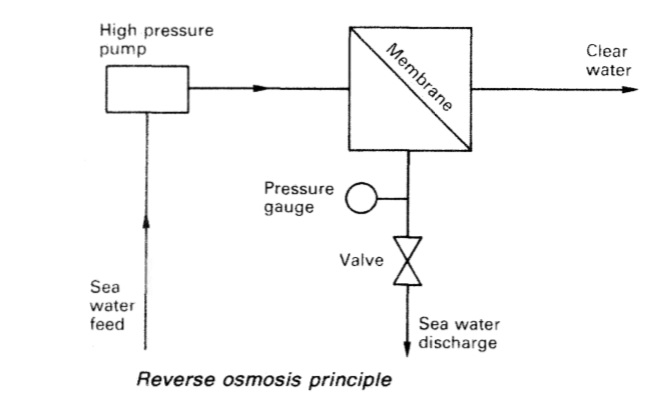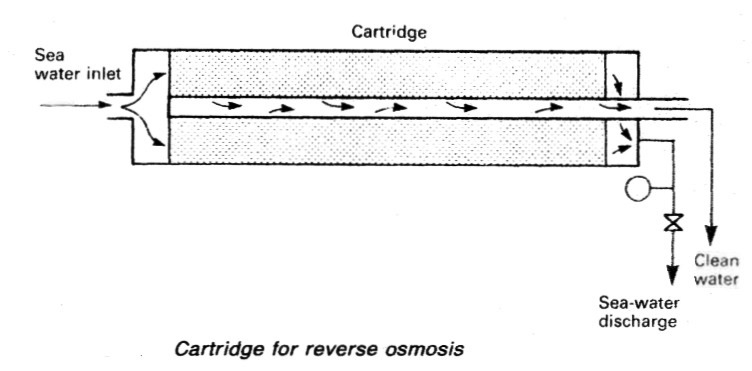
Home page||General service system ||
Reverse osmosis - Ship service systems
Osmosis is the term used to describe the natural migration of water from one side of a semi-permeable membrane into a solution on the other side. The
phenomenon occurs when moisture from the soil passes through the membrane covering of the roots of plants, with no loss of nutrient liquid from the plant. The membrane acts as a one way barrier, allowing the passage of water but not of the nutrients dissolved in the liquid within the root.
Osmotic pressure can be obtained by measuring the head of the solution when the action ceases. The semi-permeable membrane and the parchment are like filters. They allow the water molecules through but not the larger molecules of dissolved substances. The phenomenon is important not only for the absorption of water through the roots of plants but in animal and plant systems generally.

Figure 1:Reverse osmosis principle
Reverse osmosis is a water filtration process which makes use of semi-permeable membrane-like materials. Salt (sea) water on one side of the membrane (Figure 1) is pressurized by a pump and forced against the material.
Pure water passes through but the membrane is able to prevent passage of the salts. For production of large amounts of pure water, the membrane area must be large and it must be arranged in a configuration which makes it strong enough to withstand the very high pump pressure needed.
The man-made membrane material used for sea-water purification is produced in the form of flimsy polyamide or poiysulphonate sheets, which without backing would not be strong enough. The difficulty of combining the requirements of very large area with adequate reinforcement of the thin sheets is dealt with by making up spirally wound cartridges (Figure 3).
The core of the cartridge is a porous tube to which are attached the open edges of a large
number of envelopes each made of two sheets of the membrane material. The envelopes, sealed together on three sides, contain a sheet of porous substance which acts as the path to the central porous tube for water which is squeezed through the membranes. The envelopes are separated by coarse gauze sheets.
Assembled envelopes and separators initially have the appearance of a book opened so that the covers are in contact, the spine or binding forming a central tube. The finished cartridge is produced by rotating the actual central tube, so that envelopes and separators are wrapped around it in a spiral, to form a cylindrical shape. Cartridges with end spacers, are housed in tubes of stainless steel (Figure 2) or other material.

Figure 2: Cartridge for reverse osmosis
Output of the reverse osmosis plant is governed by the number of cartridge tubes in parallel. Quality is improved by installing sets of tubes in series. One problem with any filtration system, is that deposit accumulates and gradually blocks the filter. Design of the cartridges is therefore such that the sea-water feed passes through the spiral windings and over the membrane sheets with a washing action that assists in keeping the surfaces clear of deposit.
A dosing chemical, sodium hexametaphosphate, is also added to assist the action. The pump delivery pressure for a reverse osmosis system of 60 bar (900 lb/in2) calls for a robust reciprocating or gear pump. The system must be protected by a relief arrangement.
Pre-treatment and post-treatment
Sea-water feed for reverse osmosis plant, is pretreated before being passed through. The chemical sodium hexametaphosphate is added to assist the wash through of salt deposit on the surface of the elements and the sea water is sterilized to remove bacteria which would otherwise become resident in the filter.
Chlorine is reduced by the compressed carbon filter while solids are removed by the other filters. Treatment is also necessary to make the water product of reverse osmosis potable. The method is much the same as for water produced in low temperature evaporators.

Figure 3: Spirally wound cartridge for reverse osmosis
Summarized below some of the basic procedure of machinery service systems and equipment :
- Ballast arrangements
The ballasting of a vessel which is to proceed without cargo to the loading port is necessary for a safe voyage, sometimes in heavy weather conditions. On arrival at the port the large amount of ballast must be discharged rapidly in readiness for loading....
- Cargo ships bilge systems
The essential purpose of a bilge system, is to clear water from the ship's 'dry' compartments, in emergency. The major uses of the system, are for clearing water and oil which accumulates in machinery space bilges as the result of leakage or draining, and when washing down dry cargo holds. The bilge main in the engine room, has connections from dry cargo holds, tunnel and machinery spaces.....
- Bilge system layout details
All bilge suctions have screw down non-return valves with strainers or mud boxes at the bilge wells. Oily bilges and purifier sludge tanks have suitable connections for discharge to the oily water separator or ashore. The system is tailored to suit the particular ship......
- Domestic water system
Systems using gravity tanks to provide a head for domestic fresh and sanitary water, have long been superseded by schemes where supply pressure is maintained by a cushion of compressed air in the service tanks....
- Reverse osmosis
Osmosis is the term used to describe the natural migration of water from one side of a semi-permeable membrane into a solution on the other side. The
phenomenon occurs when moisture from the soil passes through the membrane covering of the roots of plants,....
- Salinometer features
The condensate or product, if of acceptable quality, is delivered to the appropriate tanks by the distilled water pump. Quality is continuously tested by the salinometer both at start up and during operation. If the device registers an excess of salinity it will dump the product and activate the alarm using its solenoid valves. The product is recirculated in some installations......
- Sewage systems
The exact amount of sewage and waste water flow generated on board ship is difficult to quantify. European designers tend to work on the basis of 70 litres/person/day of toilet waste (including flushing water) and about 130-150 litres/person/day of washing water (including baths, laundries, etc.). US authorities suggest that the flow from toilet discharges is as high as 114 litres/person/day with twice this amount of washing water......
- Sewage zero discharge system
A retention or holding tank is required where no discharge of treated or untreated sewage is allowed in a port area. The sewage is pumped out to shore reception facilities or overboard when the vessel is proceeding on passage at sea, usually beyond the 12 nautical mile limit. ...
- Biological sewage treatment
A number of biological sewage treatment plant types are in use at sea but nearly all work on what is called the extended aeration process. Basically this consists of oxygenating by bubbling air through or by agitating the surface. ....
- Sterilization system
Sterilization by the addition of chlorine, is recommended in Merchant Shipping Notice M1214. A later notice, M1401, states that the Electro-Katadyn process in use since the 1960s, has also been approved. Another problem with distilled water is that having none of the dissolved solids common in fresh water it tastes flat. It also tends to be slightly acidic due to its ready absorption of carbon dioxide (CO2). .....
- Treatment of water from shore
There is a risk that water supplied from ashore may contain harmful organisms which can multiply and infect drinking or washing water storage tanks. All water from ashore, whether for drinking or washing purposes, is to be sterilized. When chlorine is used, the dose must be such as to give a concentration of 0.2 ppm....
- Water production low pressure evaporator
A considerable amount of fresh water is consumed in a ship. The crew uses on average about 70 litre/person/day and in a passenger ship, consumption can be as high as 225 litre/person/day. Water used in the machinery spaces as make up for cooling system losses may be fresh or distilled but distilled water is essential for steam plant where there is a water tube boiler.
Steamship consumption for the propulsion plant and hotel services can be as high as 50 tonnes/day.....
- Flash evaporator system
The evaporator , boils sea water at the saturation temperature corresponding to the uniform pressure through the evaporation and condensing chambers. With flash evaporators the water is heated in one compartment before being released into a second chamber in which the pressure is substantially lower......
- Oil content monitor system
In the past, an inspection glass, fitted in the overboard discharge pipe of the oil/water separator permitted sighting of the flow. The discharge was illuminated by a light bulb fitted on the outside of the glass port opposite the viewer......
- Oily water separator
Oil/water separators are necessary aboard vessels to prevent the discharge of oil overboard mainly when pumping out bilges. They also find service when deballasting or when cleaning oil tanks. The requirement to fit such devices is the result of international legislation....
Home page||Cooling ||Machinery||Services ||Valves ||Pumps ||Auxiliary Power ||Propeller shaft ||Steering gears ||Ship stabilizers||Refrigeration||Air conditioning ||Deck machinery||Fire protection||Ship design
||Home ||
General Cargo Ship.com provide information on cargo ships various machinery systems -handling procedures, on board safety measures and some basic knowledge of cargo ships that might be useful for people working on board and those who working in the terminal. For any remarks please
Contact us
Copyright © 2010-2016 General Cargo Ship.com All rights reserved.
Terms and conditions of use
Read our privacy policy|| Home page||


